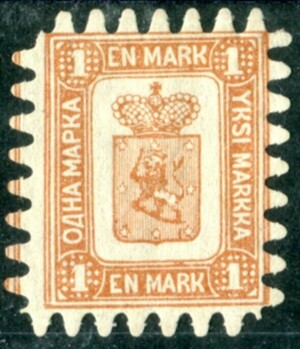FOCUS ON FINLAND

A vast flat land of forests and lakes, book-ended by Sweden and Russia,Finland has throughout history been dominated by it neighbours. However, it has its own non-Indo-European language (related to Hungarian and Turkish) and culture.
When stamps were first introduced in 1856, it was a Grand Duchy within the Russian Empire. The first two stamps, a simple oval design, were also used on postal stationery. Beware stationery cutouts (these an be recognised as they are on diagonally laid paper).
Then came the serpentine roulette stamps of 1860 etc. Three types of rouletting were tried but none worked well; the "teeth" often tore unevenly, resulting in poorer quality stamps for the collector. A full set of teeth are rare on these stamps; the odd broken tooth is usually considered acceptable for a place in normal collections that are not for competitive display.
The next series of1875 Arms, 1885 new colours, and 1889 new Arms design offer nice postmarks (sometimes in colour, and cork cancels), as well as shades.
From 1891 Russia increased its influence, reflected in the Russian-style stamps until 1917. Only small design elements (extra circles in the 1891 issue, and Finnish currency from 1901) make them different from normal Russian stamps. In fact Russian stamps were also valid for postage in Finland from1891.
As WWI drew to a close, Finland made itself an independent republic, bringing in the famous Lion stamps, an emblem used even to this day on definitives. The first design (1917-27) offers many variation of paper, perforation and watermark, an ideal subject for a "technical" specialised collection.
Print runs of most issues were fairly large and widely used. Only the 1930 Zeppelin overpint is scarce, because it was intended for Zeppelin mail alone and only available in Helsinki at the time of a special Graf Zeppelin flight which landed there in September 1930. One stamp in each sheet had the date error "1830".
The battle against tuberculosis and aid for the Red Cross were supported by regular series of surtax stamps from the 1920s to modern times.
During WWII, Finland fought the heroic Winter War against Russia to maintain independence, and then accepted joint operations with Germany as a defence against Russian incursions. Postal history from this period can document the border changes.
- Published
- 25/06/23 08:14:00 AM
